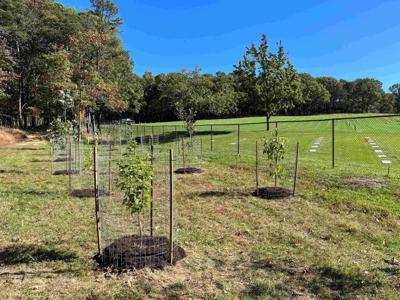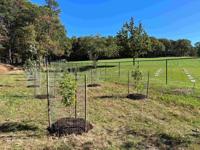MARYLAND -At the start of the new year, the 5 Million Trees Initiative is approaching a milestone, with nearly half a million trees planted.
More than 180,000 trees were planted in Maryland in 2023 as part of the initiative, bringing the total number to 471,890 trees, according to Maryland Department of the Environment data.
“It’s exciting to already be at nearly 10 percent of the state’s goal after just the first two years of the initiative,” said Maryland Department of Natural Resources Secretary Josh Kurtz. “A massive tree planting effort like this one requires coordination between tree nurseries, volunteers, and dozens of partner organizations. We believe the infrastructure and partner development is now in place to begin accelerating our planting efforts and make sure Maryland reaches its 5 million tree planting goal by 2031.”
The Maryland Department of the Environment tracks and coordinates the initiative. Maryland Department of Natural Resources planting programs have accounted for 321,000 trees, or about two out of every three trees planted as part of the initiative. Community organizations, private partners, and other state agencies have also planted trees that were counted towards the overall goal.
The 5 million tree planting goal was launched after the General Assembly passed the Tree Solutions Now Act of 2021, with plantings beginning in July of that year. The act directed the planting of 5 million native trees on Maryland’s public and private land by 2031. These plantings are on top of the state’s standard levels of tree planting of about 100,000 trees annually, which are not included in the count.
The act also mandated that 500,000 trees be planted in underserved urban areas, to support equitable distribution of the benefits trees provide. As of the latest count, 36,745 trees were planted in underserved areas.
The initiative supports Maryland’s 2030 Greenhouse Gas Emissions Reduction Act Plan, which outlines a plan for a 50% reduction in greenhouse gas emissions by 2031. The additional trees will expand the state’s carbon sinks – physical features that absorb more carbon than they release – allowing for greater carbon sequestration, which helps mitigate climate change.
The trees will also reduce urban heat islands and help to beautify communities. As part of the effort, DNR is targeting areas along waterways and coasts where trees act as riparian buffers, reducing pollutants that enter the water.
“The progress we’ve made toward 5 million trees is encouraging,” said J.T. Bowers, associate director of the Maryland Forest Service. “It’s taken time to set up the infrastructure for this much planting, but we’re at a good place now, and we’re looking at some big steps in the near future that will get more trees in the ground.”
This year’s number was outpaced by the 260,000 trees planted in 2022, the first full year of the program, though the 2023 count might not yet reflect all the trees planted in the fall. Bowers also said the progress toward 5 million is not going to be linear. This year was an important year for setting the groundwork for future work ahead.
Staff are preparing for an intensive planting season in the spring, with about 100,000 trees scheduled to be planted in partnership with the Maryland Park Service alone, Bowers said. This year, staff have also identified hundreds of acres of parkland for new tree plantings.
DNR recently hired 13 new staff members focused on the project, including 10 outreach specialists who will work with landowners and communities across the state to build up networks to assist with tree plantings.
The Ayton State Tree Nursery, which provides a vast majority of the saplings for the initiative, is also hiring new staff to significantly increase its capacity, from 2 million to 4 million saplings annually.
“We definitely have a big spring season ahead of us,” Bowers said. “The hiring we’ve done at the end of 2023 is really encouraging. We have a lot of intelligent and committed staff who are getting the word out and developing projects with a wider range of partners than we ever could have before.”
"The work can be challenging, especially because need to be monitored and cared for after planting," Bowers said. According to the DNR, staff works to maintain trees, especially for communities that don’t have resources to do so themselves. Once a tree survives for two years, it has a much greater chance of lasting into maturity.







